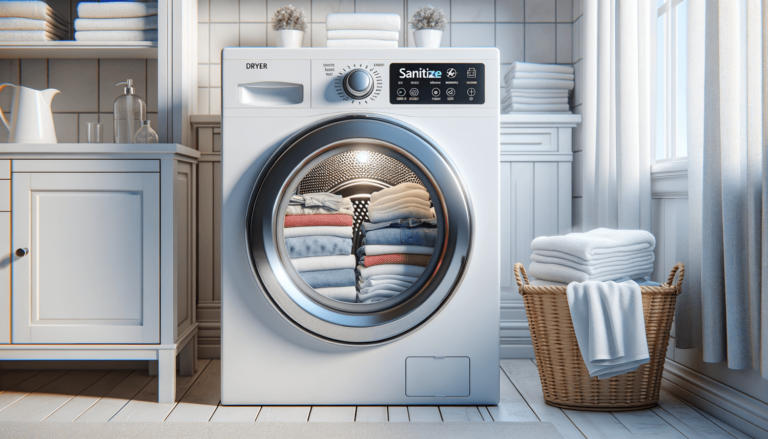

The sanitize setting on a dryer uses high heat to kill 99.9% of bacteria and eliminate allergens, ensuring hygienic and thoroughly dried laundry.
The dryer sanitize cycle is a feature that uses high heat to eliminate bacteria and allergens. It is designed to sanitize items like pillows, stuffed animals, and bedding. During the cycle, the dryer reaches around 135-150 degrees Fahrenheit, ensuring a thorough sanitization process.
The sanitize cycle on a dryer is a feature that uses high heat to eliminate bacteria, allergens, and other germs from clothing and fabrics. It is particularly useful for items that cannot be washed with water, such as stuffed animals or delicate garments. The sanitize cycle helps ensure a thorough cleaning and can benefit individuals with allergies or sensitivities.
At Settings King, we believe that properly understanding your dryer’s features is the key to optimizing your laundry routine. In particular, the sanitize mode on a dryer can improve hygiene and provide allergy relief for your family.
The sanitize cycle, found in some modern dryers, utilizes high temperatures to reduce the presence of common allergens and destroy bacteria on fabrics. By raising the heat beyond the standard setting, it effectively eliminates up to 99.9% of germs that might otherwise survive in your freshly washed clothes. These high temperatures also make the sanitize mode an excellent option for eradicating dust mites and pet dander from your linens.
In addition to the sanitize feature, there are other excellent dryer settings, specifically designed to cater to different needs:
The steam refresh setting is ideal for quickly reviving slightly wrinkled clothing, and reducing the need for an iron. It uses steam to moisten and loosen fabric fibers, while gentle heat smooths out the creases.
This setting intermittently tumbles the laundry, after the drying cycle has ended, to prevent wrinkles from setting in. This is especially useful if you cannot immediately remove your clothes from the dryer.
To get the best results from your dryer, stay informed and take advantage of these advanced dryer settings for optimal laundry care.
The sanitization feature on modern dryers has become increasingly useful due to heightened concerns over hygiene and allergen control. At Settings King, we seek to empower you with the knowledge you need to maximize your dryer’s capabilities.
It is important to know that the sanitize mode sets itself apart from the more common settings, such as regular or permanent press drying. These usual dryer settings focus on the optimal drying time and temperature for different fabric types, whereas the sanitize mode is specifically engineered to remove germs and allergens for a deeper level of cleaning.
With the growing awareness of maintaining a healthy home environment, sanitizing your laundry has become essential. This process is especially relevant for families with members suffering from allergies or asthma and households with pets that may contribute to allergen buildup on clothing and linens. Moreover, properly sanitized laundry helps as an added measure in reducing infection risks.
While the sanitize mode adds extra benefits to your laundry routine, it’s essential to understand when to use it:
Taking full advantage of the sanitize setting on your dryer also requires attention to your washer settings. Selecting a high-temperature wash cycle, utilizing detergent with disinfecting properties, and properly sorting laundry can help in achieving the best possible outcomes for sanitized clothing and linens.
By using the sanitize feature on your dryer mindfully and efficiently, you will improve your home’s health and safety and extend the life of your garments by prioritizing cleanliness and care.
To further assist you in utilizing the sanitary capabilities of your dryer, Settings King has compiled a list of frequently asked questions related to this valuable dryer setting. These quick answers can help provide more guidance and clarification:
Sanitize mode may not be suitable for all fabric types due to high heat exposure. Always follow the care instructions on your clothing or linens and use sanitize mode primarily on heat-tolerant fabrics like cotton, polyester, and linen.
Not all dryers come with a sanitize mode. This feature is usually found in newer models, so check your dryer’s user manual to verify if it is included and learn how to properly utilize it.
Yes, you can use fabric softener sheets in combination with sanitize mode to make your laundry soft and fragrant, while simultaneously eliminating allergens and bacteria. Be sure to follow the instructions on the softener sheets packaging for optimal results.
While sanitize mode does require higher heat, its energy consumption depends on your dryer’s efficiency and the frequency of use. To save energy, limit the use of sanitize mode to situations when deep-cleaning is necessary or prioritize using energy-efficient dryers.
Sanitize mode generally takes longer than regular drying cycles due to the high-heat treatment. Exact duration varies depending on your dryer model, load size, and fabric types. Check your user manual to learn more about cycle times associated with your specific appliance.